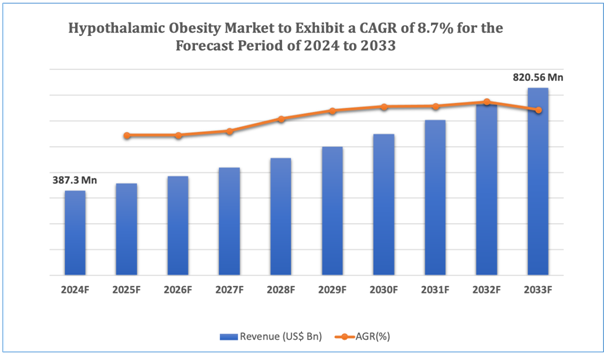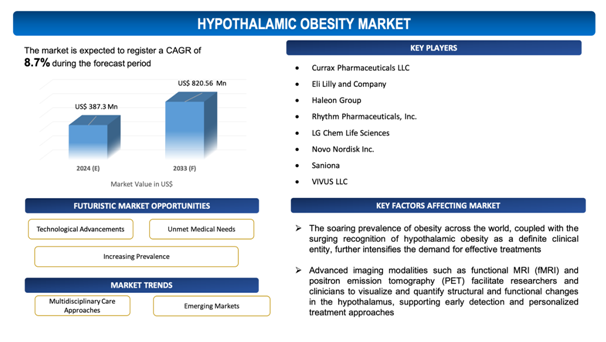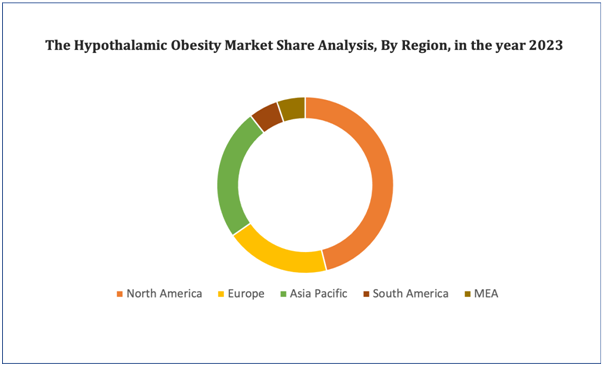Hypothalamic Obesity Market Overview
The global Hypothalamic Obesity market is estimated to be worth over USD 820.56 Mnin 2033 and is expected to grow at CAGR of 8.7% during the forecast period (2024-2033). Hypothalamic obesity is a complicated condition leading from harm to the hypothalamus, oftentimes due to injury, surgery, or certain medical treatments. The hypothalamus holds an integral role in metabolism, regulating appetite, and energy expenditure. When it is damaged, patients can undergounmanageable weight gain, regardless of the efforts to manage diet and exercise. This obesity is time and againjoined by metabolic disturbances, such as dyslipidemiaand insulin resistance, further fueling the risk of cardiovascular diseases and other complexities. Managing hypothalamic obesity presents asignificant challenge, as traditional weight loss strategies are likely to be ineffective. Instead, a multidisciplinary approach comprising physical activity, dietary modifications, behavioral therapy, and sometimes pharmacotherapy is needed. In serious cases, surgical interventions like bariatric surgery are likely to be considered. The global market for hypothalamic obesity management comprises medical devices, pharmaceuticals, and services catering to the diagnosis, treatment, and support of affected individuals. The market is encouraged by the growing prevalence of obesity across the world and the increasing recognition of hypothalamic obesity as a distinct clinical entity. However, the market witnesses’ challenges such as limited awareness among healthcare providers and patients, as well as the intricacy of administering this condition effectively. Research and development efforts are underway to develop novel therapeutics and interventions targeting the underlying mechanisms of hypothalamic obesity, providing hope for enhanced outcomes and quality of life for affected individuals. Overall, addressing the unfulfilled needs of patients with hypothalamic obesity represents a significant opportunity for innovation and growth in the global healthcare market.
Figure 1. Hypothalamic Obesity: Market Size

Get more details on this report - Request Free Sample
Key Market Insights &Current Market Landscape:
The global hypothalamic obesity market is witnessing significant growth driven by several key market insights and recent developments. With an increasing understanding of the complex mechanisms underlying hypothalamic obesity, pharmaceutical companies are focusing on developing innovative treatments targeting appetite regulation and metabolic dysfunction. Recent launches include novel medications aimed at modulating pathways involved in hunger signaling, such as melanocortin receptor agonists and combination therapies addressing both obesity and its metabolic comorbidities. Moreover, advancements in medical devices and surgical techniques offer additional options for managing severe cases of hypothalamic obesity, providing patients with alternative treatment modalities beyond conventional pharmaceutical interventions. The market landscape is characterized by a growing emphasis on multidisciplinary approaches, integrating lifestyle modifications, behavioral therapy, and medical interventions to optimize outcomes for affected individuals. Additionally, the rising prevalence of obesity globally, coupled with increasing awareness and recognition of hypothalamic obesity as a distinct clinical entity, is driving market expansion. However, challenges persist, including limited awareness among healthcare providers and patients, as well as reimbursement hurdles for emerging therapies and interventions. Nonetheless, ongoing research and development efforts hold promise for further innovations in the treatment of hypothalamic obesity, offering hope for enhanced outcomes and quality of life for affected individuals in the evolving panorama of the global healthcare market.
Market Dynamics
Market Drivers
Rising Approval of New Drugs
As traditional treatment alternatives often prove ineffective in administering this intricate condition, there is an urgent need for advanced therapies that tackle the underlying mechanisms of hypothalamic dysfunction. Pharmaceutical firms are thus incentivized to invest in research and development efforts focused at discovering novel agents targeting metabolic pathways, appetite regulation, and neuroendocrine dysfunction related to hypothalamic obesity.
In addition to that, the soaring prevalence of obesity across the world, coupled with the surging recognition of hypothalamic obesity as a definite clinical entity, further intensifies the demand for effective treatments. Patients and healthcare providers alike seek novel therapeutic alternatives that offer better safety, efficiency, and tolerability profiles in comparison to existing interventions. This demand for innovation not only fuels market growth but also facilitates competition among companies to develop leading-edge therapies, ultimately benefiting individuals affected by hypothalamic obesity by expanding treatment options and enhancing outcomes.
Market Restraints
With regard to numerous advantages of Hypothalamic Obesity, the market faces several challenges due to the unique characteristics and requirements associated with them. Some of the key market challenges include:
- Limited Awareness: Notwithstanding with the advances in understanding hypothalamic obesity, there remains a substantial lack of awareness among healthcare providers and patients about the condition, paving its way to the underdiagnosis and inadequate access to appropriate treatments.
- Reimbursement Challenges: The reimbursement panorama for therapies targeting hypothalamic obesity is complicated and oftentimes restrictive, impeding patient access to novel treatments and posing a barrier to market growth for pharmaceutical firms and healthcare providers alike.
Market Opportunities
Technological Advancements
As the understanding of the underlying pathophysiology of hypothalamic dysfunction persists to evolve, technological advancements and novel innovations provide new horizons for diagnosis, treatment, and monitoring of this intricate condition. Advanced imaging modalities such as functional MRI (fMRI) and positron emission tomography (PET) facilitate researchers and clinicians to visualize and quantify structural and functional changes in the hypothalamus, supporting early detection and personalized treatment approaches. In addition, innovations in genetic sequencing technologies enable for the determination of rare genetic mutations related to hypothalamic obesity, leading the way for precision medicine interventions customized to individual genetic profiles. Along with that, the development of digital health solutions, comprising wearable devices, mobile apps, and telemedicine platforms, improves patient engagement, allows remote monitoring of vital signs and metabolic parameters, and promotes real-time feedback and support for lifestyle modifications. These technological innovations not only enhance the effectiveness and efficiency of clinical care but also encourage research and development initiatives, resulting in the discovery of novel therapeutic targets and interventions. Overall, the integration of state-of-the-art technologies into the management of hypothalamic obesity holds immense potential to revolutionize patient care and accelerate market growth in the forthcoming years.
Market Trends
- Multidisciplinary Care Approaches: A striking trend in the global hypothalamic obesity market is the adoption of multidisciplinary care approaches, including collaboration among different healthcare professionals such as dietitians, endocrinologists, psychologists, and bariatric surgeons. This trend determines the complicated nature of hypothalamic obesity and focused on the prominence of addressing both physical and psychological aspects of the condition for comprehensive management and enhanced patient outcomes.

Get more details on this report - Request Free Sample
Hypothalamic Obesity Market: Key Segments
By Treatment Type
- Anti-Obesity Drugs
- Pituitary Hormonal Replacement
- Physical Activity
- Bariatric Surgery
- Others
By End-User
- Hospitals
- Specialty Clinics
- Ambulatory Surgical Centers
- Academic and Research Institutes
- Others
By Key Geographical Regions
- North America
- Europe
- Asia-Pacific
- Middle East and Africa
- South America
Hypothalamic Obesity Market: Regional Analysis
North America region is expected to hold the largest market share over the forecast period owing to the strong presence of major players and increasing prevalence in the region. North America especially the United States is known for its strong presence of major players such as pharmaceutical companies. The presence of major players is known to actively perform in clinical trials, which helps to the launch of novel therapeutics and alternative treatment options.
Figure 4. Hypothalamic Obesity Market: Distribution by Region

Get more details on this report - Request Free Sample
Leading Hypothalamic Obesity Developers
Industry Trends and Global Forecasts, 2023-2035 report features an extensive study of the current market landscape, market size and future opportunities associated with the Hypothalamic Obesitymarket, during the given forecast period. Further, the market report highlights the efforts of several stakeholders engaged in this rapidly emerging segment of the biopharmaceutical industry. Key takeaways of the Hypothalamic Obesitymarket are briefly discussed below.
The report includes the list of players operating in the global Hypothalamic Obesitymarket. Some of the key players include:
- Currax Pharmaceuticals LLC
- Eli Lilly and Company
- Haleon Group
- Rhythm Pharmaceuticals, Inc.
- LG Chem Life Sciences
- Novo Nordisk Inc.
- Saniona
- VIVUS LLC
Recent Developments in the Hypothalamic Obesity Market
Several recent developments have taken place in the field of Hypothalamic Obesity, some of which have been outlined below. These developments, even if they took place post the release of our market report, substantiate the overall market trends that we’ve outlined in our analysis chronologically.
- On November, 2022, Rhythm Pharmaceuticals, Inc., a commercial-stage biopharmaceutical company focused on transforming the lives of patients and their families living with hyperphagia and severe obesity caused by rare melanocortin-4 receptor (MC4R) pathway diseases, announced that setmelanotide received Breakthrough Therapy Designation from the U.S. Food and Drug Administration (FDA) for the treatment of hypothalamic obesity.The FDA's Breakthrough Therapy Designation is designed to expedite development and review of medicines that aim to address a serious condition with an unmet medical need with preliminary clinical evidence indicating that the drug may demonstrate substantial improvement over existing treatments on one or more clinically significant endpoints.
Scope of the Report
The market report presents an in-depth analysis of the various firms / organizations that are engaged in this market, across different segments, as defined in the below table:
|
Key Report Attributes |
Details |
|
Base Year |
2023 |
|
Forecast Period |
2024-2033 |
|
CAGR (2024-2033) |
8.7% |
|
Treatment Type |
|
|
End User |
|
|
Key Geographical Regions |
|
|
Key Companies Profiled |
|
